Characteristics of pipes for water heated floors
The construction of a water heated floor is a complex and time-consuming process, especially when using a concrete screed and the need to reinforce the structure. Therefore, great demands are placed on the pipes that are planned to be laid in the “pie”.
Important! The use of standard PVC water pipes is prohibited.
Since they cannot withstand high loads that are formed due to high temperatures and pressure created in the pipeline.
The main requirement for a pipeline in a warm water floor, both in a private house and in an apartment, is durability and tightness. It is necessary that during a sharp temperature change the system does not depressurize.
After all, if there is a screed, it is difficult to find and eliminate the defect. In addition, it must withstand the effects of aggressive chemical compounds found in the coolant and mechanical loads. The elasticity of the contour is of no small importance - it should bend easily.
We should not forget about the level of thermal conductivity when choosing a coil for water-type underfloor heating; the higher this coefficient, the more efficiently the device works. And also, regarding the degree of expansion when heated, up to 0.25 mm/mK is considered acceptable.
Pipes are produced in coils with a certain footage. When purchasing, remember that the loops must be solid, without joints.
For your information! The pipeline for heated water floors must be marked to permit their use in heated floors.
Which pipes are suitable for heated floors?
Contours are made from various materials, the strength and cost are affected by its features and characteristics. Each model has positive and negative sides.
Polymer
Polymer is a common material; several types of pipes for water heating floors are made from it. It is chemically neutral, which makes it more resistant to high temperatures, up to +95 degrees.
For your information! Polymer pipes that are intended for installation in water-heated floors are marked PN 10. If available, the maximum temperature for such a pipeline is 55 degrees.
There are several types of polymer pipes:
- Cross-linked polyethylene is a new type of polyethylene in which the molecules are interconnected by cross-links. As a result, the material is obtained with a stable structure and improved quality characteristics.
Let's look at its properties:
- not subject to corrosion and chemicals;
- elastic - pipes made from it are flexible and can be easily bent at any angle, without the use of special equipment;
- has increased resistance to sudden temperature changes;
- The product has a small roughness coefficient inside - this reduces hydraulic resistance.
For your information! A coil made of cross-linked polyethylene has a structural memory - when heated, the product takes on its original shape.
This pipeline is available in several types, depending on the cross-linking technology:
- PEX-a - peroxide cross-linking, polyethylene is heated under high pressure in the presence of peroxides, the resulting material is strong and elastic, it can withstand heating up to 95 degrees;
- PEX-b - cross-linking is carried out using silane technology, polyethylene is exposed to chemicals, most often silane, which imparts resistance to oxidation and makes it rigid;
- PEX-c - the finished product is irradiated with electrons, little used on the Russian market;
- PEX-d is nitrogen-based; the production process of this type is complex, so it is not widespread.
All types of PEX pipes can be used for underfloor heating systems. However, PEX-b and PEX-c are more popular, as they are more elastic and have a small bending angle. PEX-a has a high degree of cross-linking, so installation requires special equipment. In addition, this model costs much more than its analogues.
- Polyethylene with increased heat resistance PE-RT is a modified type, the main component is octene. The difference between this material and PEX pipes is that it is seamless, there is no need to additionally stitch it, since the structure has a stable molecular lattice.
A device with a PE-RT coil operates silently, even when coolant passes through it under high pressure. Able to withstand high negative temperatures. The service life of heat-resistant polyethylene is several decades.
This PE tolerates high temperatures and high pressure well, but not for a long time. In addition, it is not able to withstand aggressive substances and does not have structural memory.
However, PE-RT increasingly fits into the “pie” of a heated water floor, due to its affordability.
- Polypropylene - have a lot of advantages and are intended for water supply systems and radiator heating. But they cannot be used in heated floors, since they have:
- short length - not enough for floor hinges;
- poor ductility - almost impossible to bend at the desired angle;
- low thermal conductivity - it is difficult to ensure the necessary heat exchange between the circuit and the floor surface.
- Copper - not used often. Firstly, the cost of copper pipes for heated floors is much higher than other models. And secondly, laying a copper pipeline is a rather complex process, and it cannot be done without specialized equipment and strict adherence to technological rules. That is, you won’t be able to make a water floor yourself from these pipes.
In addition, they are subject to thermal expansion, even reinforced ones - when pouring screed, the pipes will experience increased internal pressure, which will affect their durability.
Therefore, despite the low price of polypropylene pipes, it is not recommended to install them in the construction of warm water floors, but if you still decide to install using polypropylene materials, read the article on the best way to install them.
Metal
Metal pipes are produced:
However, it is worth noting that copper coils have ideal characteristics for placement in the “pie” of a water-heated floor. Since, copper:
- excellent heat conductor - will provide high heat transfer;
- durable and not subject to corrosion;
- plastic - if the technology is followed correctly, the bending radius can be minimal;
- has high mechanical strength and is not afraid of high temperatures.
For your information! Many manufacturers cover the top of the product with a polymer film, which protects it from the aggressive effects of chemicals contained in the concrete screed solution.
- Corrugated stainless steel - this type appeared on the market recently, but has already proven itself on the positive side. Since the pipes are made of stainless metal, they are not subject to corrosion. In addition, they are equipped with an additional protective polymer coating.
It is worth noting the good flexibility of the pipeline and the ability to hold the laid bend, which is important when laying a complex circuit. In addition, due to the flexibility of the product, contour fracture is completely eliminated.
It is impossible not to mention the resistance of corrugated pipes to various types of influence: mechanical, temperature and chemical.
Pipes are produced in coils, 30 or 50 meters long. This is not always enough to make a complete loop. However, the method of connecting these pipes with fittings is so perfect that the nodes can be placed under the screed. This is the only type of pipeline whose joining areas are allowed to be filled with concrete.
The price for this model is quite high, which is why laying corrugation in heated floors is not popular.
For your information! VGP steel pipes should absolutely not be used when installing warm water floors.
Metal-plastic
The metal-plastic pipeline is all-welded, connected by laser or ultrasound. This type is often used in underfloor heating designs. One of the reasons is the excellent flexibility of plastic; it is easy to bend even without heating. It is durable, resistant to temperature changes and environmentally friendly.
The product goes on sale in bottles up to 50 meters, this allows you to lay solid loops in small rooms. For large areas, the bottles are supplied with a contour of up to 90 meters.
A plastic pipeline with a metal layer is a multilayer structure and consists of:
- inner layer - cross-linked polyethylene;
- metallized - aluminum foil of different thicknesses;
- external - a thin polymer coating to protect against mechanical damage.
For your information! This metallized design does not allow the formation of corrosion, since the inside surface is smooth, which does not contribute to deposits and reduces hydraulic resistance.
A variety of connecting fittings for metal-plastic pipes makes installation easy and quick. And if you follow the rules during installation and operation, the product will last more than 50 years.
Another advantage of metal-plastic products is their high thermal conductivity, in comparison with a hose made of cross-linked polyethylene, which allows you to quickly warm up the surface. The disadvantage is the possibility of the pipeline being broken, in which case it will be necessary to remove this section of the product, since there is no ability to restore its shape.
Polypropylene and cross-linked polyethylene raw materials
This product is durable, affordable, and natural. The demand for these products is low compared to copper ones. This material is not suitable for northern regions. It is not recommended to install it at air temperatures below -15°C.
Such pipes are quite flexible and convenient
Cross-linked polyethylene is a material made from hydrocarbon molecules. During the production process, hydrogen and carbon atoms are combined with each other. To increase strength, the products are additionally processed under high pressure.
The material has excellent quality: resistance to temperature changes, resistance to mechanical stress. To install this structure, it is recommended to purchase products with a degree of crosslinking of at least 80%. These parameters affect the durability of use.
Such products are distinguished by their plasticity, resistance to pressure surges, ductility, safety, and the ability to return to their original appearance. The raw material does not burst at low and very high temperatures.
Installation work is not difficult and does not require the use of expensive equipment. The goods should be transported carefully. If damaged, oxygen may enter the structure, which will negatively affect the use of the product.
These pipes are preferable to the previous ones, but polyethylene is easily damaged during installation. The smallest bend radius is 5 outer pipe diameters (for polypropylene pipes – 8). PE pipes for installing underfloor heating systems can withstand a maximum water temperature of 120°C. To install PE pipes, a large amount of fasteners is required, since the pipes do not hold their shape after bending.
Marking: HDPE – pipes with the highest density, MDPE – with medium density, LDPE – with low density.
Do cross-linked polyethylene (PE-X) pipes have increased strength and resistance to deformation? temperature and pressure changes, such pipes are more flexible, lightweight, and environmentally friendly. They are produced with an outer diameter from 10 to 110 mm, wound in coils of 200 meters, which reduces the number of seams and simplifies installation. During installation, fittings for metal-plastic and axial technology are used.
We suggest you read How to paint an old door white
Polyethylene is cross-linked using peroxide, silane gas or electrons in an electromagnetic field. The processing method affects the strength of the product. The highest quality pipes are cross-linked with peroxide (marked PE-Xa).
PEX pipes are particularly soft and elastic. They are wear-resistant and durable. Supplied in large coils up to 600 meters. Due to this, they can be laid in a single line without soldering or additional fastenings, which eliminates the risk of leakage or mechanical damage during installation. Durable - service life up to 50 years.
They have high temperature resistance without loss of service life. Withstands temperatures up to 95°C. In addition, such a pipe can be filled with concrete. The only negative is that due to their elasticity, they need to be fixed to the floor with additional clamps to avoid unwinding. If you answer the question which pipe for a water heated floor is better or optimal in terms of price and quality, then cross-linked polyethylene will be the leader here.
PEX-A (peroxide cross-linked). The technology used when stitching this type of polyethylene pipes ensures a uniform and high degree of crosslinking, which leads to unique strength qualities. This makes the pipe durable, especially at the connection points with fittings. PEX-A is an environmentally friendly material.
PEX-B (silanol cross-linked). Less expensive stitching method. Unlike PEX-A, after extrusion the degree of crosslinking does not exceed 15%, which requires additional heat treatment at high temperatures to increase the degree of crosslinking. It is a less environmentally friendly material. The cost of PEX-B is lower than the cost of PEX-A.
How to calculate the length of a pipe for a heated floor?
Watch the installation video on how to make calculations and which pipe materials to choose and why.
The size of the contour for a water floor should be determined when designing the structure. Its length depends on the laying step. The standard pitch ranges from 100 to 300 mm.
The simplest method to calculate the length of the pipeline is to take the average figure, per 1 m2 - 5 meters of contour, with a step of 200 mm.
A more accurate way is to use the formula
L = S / N * 1.1, where:
L—contour length;
S is the area of the room;
N—laying step;
1.1 - stock of product for rotation.
The calculation for each floor loop must be done separately, and then add up all the indicators. In addition, you should not forget to add the distance from the floor to the collector.
For your information! If the result obtained exceeds the permissible loop size - 120 meters, then the room must be divided into several loops.
You can simplify the calculation process by using an online calculator to determine the length of the pipeline.
Contour laying
Plastic products with a diameter of 16-20 mm and a wall thickness of 2 mm are well suited for underfloor heating. Installation is carried out using a “snail” or “snake”. When performing a “snail”, the pipe laying step can be minimal, but not less than 10 cm. If the contour is positioned as a “snake”, then the turn of the line must be at least 5 diameters. When choosing a 16 mm product, the bending radius cannot be less than 8-10 cm; provide the same distance of pipes on a warm floor.
We recommend: How to install PERT pipes for heated floors?
For effective heating, it is necessary to correctly calculate the amount of pipe for underfloor heating. If a product with a diameter of 16 mm is used, then the maximum length of the system is 100 m; for 18 mm – 122 m; for 20 mm – 125 m. Before installing the heating system, it is necessary to make a project.
The warm circuit should not be placed under furniture or near heating appliances. 30 cm away from the wall. It is necessary to calculate the heated area of the room. To calculate the pitch and footage of the water circuit, use calculators or tables. Take into account the thickness of the screed and the thermal conductivity of the floor covering.
If the coolant that enters the system has a temperature of 30 0C, then with a pipe pitch of 20 cm the floor temperature will be 25.9 0C. At the same time, the air in the room will warm up to 22 0C. To organize a water circuit, you will need 5 m of a heating element per 1 m2 of heated surface.
To increase the floor temperature to 26.5 0C, the step is reduced to 15 cm; per 1 m2 you will need a contour of 6.7 m. These indicators are acceptable for laying a 16 * 2 mm pipe.
For underfloor heating of a bedroom, less material will be required. The optimal room temperature is 18 0C. the floor temperature should be 24 0C, the coolant 30 0C. the pitch between the coils of the “snake” is 15 cm. For 1 m2 you will need a contour 10 m long.
For an underfloor heating system, it is better to use a metal line, but plastic products are increasingly being chosen. Heating installation can be completed in a few hours. The leading manufacturers of equipment for heated floors are Germany, the Czech Republic, and Italy: the companies have dealers in Moscow and other CIS cities.
YouTube responded with an error: Access Not Configured. YouTube Data API has not been used in project 268921522881 before or it is disabled. Enable it by visiting https://console.developers.google.com/apis/api/youtube.googleapis.com/overview?project=268921522881 then retry. If you enabled this API recently, wait a few minutes for the action to propagate to our systems and retry.
We recommend: Is it possible to use underfloor heating as the main heating?
- Related Posts
- Instructions for laying heated floors
- How to install Energy heated floors?
- How to install a heated floor in a bathhouse?
- How to fill a heated floor?
- What kind of base can be used for a heated floor?
- How much does underfloor heating cost?
Selection of the optimal diameter
When choosing the diameter of the circuit, you should proceed from the length of the loop and the thermal conductivity of the material. Common sizes used in the construction of heated floors are 16, 20 and 25 mm.
When determining the diameter of the product, the following points must be taken into account:
- the smaller the diameter of the pipes, the higher the hydraulic resistance increases, and the level of heat transfer decreases;
- The larger the cross-section, the thicker the screed must be made, which increases the load on the floors and reduces the height of the ceiling.
Important! If the length does not correspond to the diameter of the circuit, this may lead to the hydraulic resistance exceeding the technical capabilities of the circulation pump.
With a pipeline length of 70 meters, it is recommended to take a pipe diameter of 16 mm. For a loop size of 90 meters, the appropriate cross-section is 20 mm, and for 120 meters, 26 mm.
When choosing the diameter of the product, it is necessary to take into account the level of heat transfer of the pipe material. When laying a copper or metal-plastic coil, it is better to use a contour with a cross-section of 14 or 16 mm. When using polymer pipes - 20 or 25 mm.
Requirements for pipes, size ratios
When installing this type of system, you should know not only what pipes are used for heated floors, but it is also very important to take into account their required length and diameter. As a rule, in heating systems and underfloor heating systems in particular, pipes with a cross-section of 16–20 mm are used.
If the cross-section of the pipe is smaller than the required one, this will lead to impaired circulation of the coolant, which, in turn, may lead to a decrease in the required temperature and additional costs for replacing communications. To avoid this, you should think through and correctly calculate all the necessary parameters in advance.
To do this, it is important to consider the following conditions:
- The area of the room in which the warm water floor will be installed.
- Type of finishing floor covering and screed composition.
- Availability of additional insulation.
- The power of the pump that moves the coolant.
- Initial pipe parameters.
Also, when calculating the required length of pipes, it is important to take into account that their consumption will depend on the installation method and the distance between them (laying pitch). In this case, the heating system should occupy the maximum area, and a distance of 25–30 cm should be made from the walls. In addition, it must be taken into account that the larger the cross-section of the pipe, the greater its permissible length should be.
So for pipes:
- with a cross section of 20 mm, the maximum length is 120–125 m;
- with a cross section of 18–19 mm, the maximum length is 120–122 m;
- for pipes 16–17 mm, the maximum length will be 100–102 m.
Specialized mats for underfloor heating systems will help you accurately follow the pipe laying step during installation. More preferable are the so-called profile mats, which have shaped protrusions for reliable fixation of pipes. There are also foil ones, but only samples with a protective polymer film have the corresponding markings.
Of course, you don’t have to resort to independent calculations, but use this service from heating pipe manufacturers. In addition, they often offer ready-made underfloor heating systems, which can be very convenient and help save time and money.
When proceeding directly to the installation of a warm water floor, you should take into account that:
- pipes must be as strong as possible and sufficiently flexible;
- It is unacceptable to make pipe connections under the screed to avoid leaks and damage to the system in them;
- Preference should be given to brands from well-known manufacturers, which will guarantee high reliability and quality of products.
Now, knowing which pipe to choose for a heated floor, you can proceed to the installation of the system itself.
Since installing a heated floor is not the easiest process, heating pipes (in no case should you use pipes for hot or cold water supply) must be durable, that is, not subject to destruction due to pressure or temperature changes, chemical or bacteriological loads. If all operating and installation standards are observed, the service life of polymer and metal-polymer pipes is more than fifty years.
In addition, the pipes must have reliable insulation and tightness, protecting the entire heating system from oxidation.
Pipes for heated floors must be elastic (bent by hand), resistant to bending (a prerequisite for high-quality installation and calculation of the distance between pipes), and not break or crack.
These requirements are met by metal-plastic (metal-polymer) pipes, copper, polyethylene, polybutane, and steel pipes.
The use of cast iron pipes is prohibited according to the code.
It is recommended to choose pipes for heated floors from well-known manufacturers. This not only guarantees good product quality, but will also allow you to receive compensation for defects in the event of a defect.
The question of which pipe is best to use for a heated floor should be taken seriously: this is explained by the specific operating conditions of a water heating system. The material must only be new and meet a whole list of technical requirements.
1. Specific gravity, manufacturing technology. Installation of “underground” heating from steel water and gas pipes is not allowed, even if they are made of stainless steel. SNiP (Building Norms and Rules) prohibit the use of welded pipes in closed floor heating systems. The ban applies regardless of the type of seam (straight or spiral).
Another disadvantage of pipes made of steel is their heavy weight. The “pie” of a heated floor, including a concrete screed, already has an impressive weight. The steel contour sharply increases the load on the floor.
2. Resistance to external influences. The durability of the contour poured with concrete depends on it. After hardening, the monolith becomes a powerful heat storage and distributor (options using “dry” screed are less effective). The only negative: diagnostics in case of breakdowns is difficult, replacing a separate section of the pipeline is almost impossible. In the event of a break, the entire system will have to be dismantled.
We invite you to familiarize yourself with the Second limit state is the calculation
To avoid such troubles, choose pipes made of a chemically inert, heat-resistant material (must withstand 90-95 °C), completely protected from corrosion, with a smooth inner surface that is not prone to the formation of lime deposits. The ideal choice is a pipe with special protection against oxygen diffusion.
3. Durability. The screed presses on the walls from the outside, and the coolant presses from the inside. Although critical pressure readings are unlikely, the pipe should be rated at 10 bar (in case of extreme surges).
4. Sufficient length. The circuit must be solid, since any connections (couplings, fittings, welding) are potential places for leaks. A gust not detected in time leads to flooding of the neighbors below or to a short circuit in the electrical network. Another argument against joints is the high probability of pipes becoming overgrown and clogging the system in these places.
The length of the contour is determined by calculation. Typically, floor heating material is supplied in coils and sold in linear metres. Plasticity allows you to give the pipe a curved shape with bends of the desired radius.
Which pipe is best to use for heated floors?
Which pipe to choose for a heated water floor depends on the characteristics of the material and the room, as well as your financial capabilities. If the means and design of the floors allow, then the ideal option is copper.
However, more often when constructing water heated floors, metal-plastic or PEX pipes are used. If we compare both types, they have almost the same characteristics:
- the elements are connected without the use of tools and extensive experience in this work is not required;
- the installation process is not long;
- the pipes bend well.
It is worth noting that a product made of metal-plastic has greater thermal conductivity and heats up quickly, but its cost is an order of magnitude higher than that of cross-linked polyethylene.
When analyzing the reliability of both types, cross-linked polyethylene takes first place, since the joints are fixed with special sealed sleeves. For metal-plastic circuits, the connection areas of pipes and fittings are open, which can lead to leaks during floor operation.
Cross-linked polyethylene also leads in terms of strength. For example, periodic defrosting and freezing of a floor with PEX pipes will not affect the circuit in any way, but a metal-plastic pipeline can break.
For your information! When constructing heated floors, heavy steel pipes cannot be used; they will increase the load on the floors.
Manufacturers rating
In addition to the characteristics, when choosing a pipe product, you need to pay attention to the brand and manufacturer. It is better to give preference to proven brands that are popular in the market.
The main and well-established manufacturers include:
- Rehau - country of origin: Germany. Specializes in the production of PEX pipes for underfloor heating and water supply, with noise-absorbing properties and an anti-oxygen barrier. The company produces products in several series, which differ in color: white, red, orange. The warranty period is 10 years, and with proper use it will work for more than 50 years. Products of this brand have high thermal insulation, strength and elasticity.
- Sanext (Italy) - produces multilayer PEX contours. They have protective properties against noise and gas penetration. The warranty period is 10 years. The permissible bending diameter is 10 cm. The company promises uninterrupted operation of the circuit for up to 50 years.
- Uponor is a Finnish manufacturer. The range is huge - metal-plastic and polyethylene reinforcement products that are not subject to corrosion and destruction under the influence of chemicals. Protective layers protect pipes from mechanical stress.
- Emmeti (Italy) - produces metal-plastic and PEX-polyethylene pipes. The company monitors the technological process, all products have quality certificates.
- Valtec is a joint production between Italy and Russia. The company produces kits for standard conditions, and has also developed fittings for non-standard premises. Kits from this brand for underfloor heating are easy to install on your own. The product is an excellent heat conductor and is not affected by chemicals.
Purchasing high-quality material guarantees efficient and durable functioning of the heated floor. In addition, with the right choice, you can create an economical and visually aesthetic floor heating system in your apartment.











